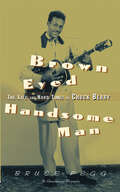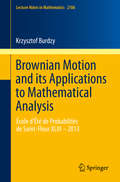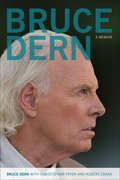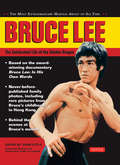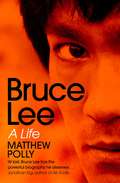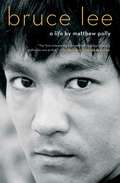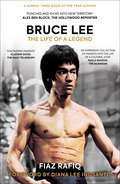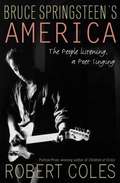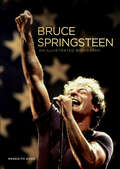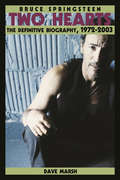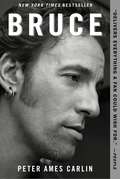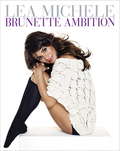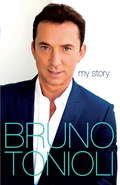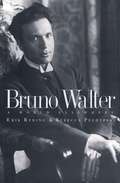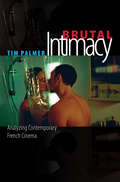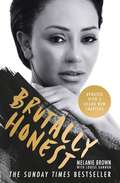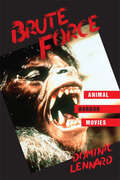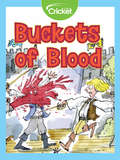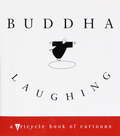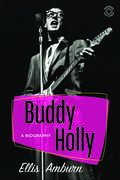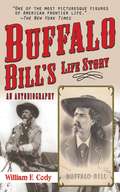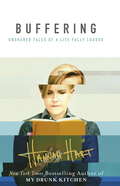- Table View
- List View
Brown Eyed Handsome Man: The Life and Hard Times of Chuck Berry
by Bruce PeggBrown Eyed Handsome Man: The Life and Hard Times of Chuck Berry draws on dozens of interviews done by the author himself and voluminous public records to paint a complete picture of this complicated figure. This biography uncovers the real Berry and provides us with a stirring, unvarnished portrait of both the man and the artist. Berry has long been one of pop music's most enigmatic personalities. Growing up in a middle-class, black neighborhood in St. Louis, his first major hit song, "Maybellene," was an adaptation of a white country song, wedded to a black-influenced beat. Thereafter came a string of brilliant songs celebrating teenage life in the '50s, including "School Day," "Johnny B. Goode," and "Sweet Little Sixteen." Berry's career rise was meteoric; but his fall came equally quickly, when his relations with an underage girl led to his conviction. It was not his first (nor his last) run in with the law. He scored his biggest hit in the early '70s with the comical (and some would say decidedly lightweight) song "My Ding-a-Ling." The following decades brought hundreds of nights of tours, with little attention from the recording industry. Bruce Pegg offers the definitive, though not always pretty, portrait of one of the greatest stars of rock and roll, a story that will appeal to all fans of American popular music.
Brownian Motion and its Applications to Mathematical Analysis: École d'Été de Probabilités de Saint-Flour XLIII – 2013 (Lecture Notes in Mathematics #2106)
by Krzysztof BurdzyThese lecture notes provide an introduction to the applications of Brownian motion to analysis and more generally, connections between Brownian motion and analysis. Brownian motion is a well-suited model for a wide range of real random phenomena, from chaotic oscillations of microscopic objects, such as flower pollen in water, to stock market fluctuations. It is also a purely abstract mathematical tool which can be used to prove theorems in "deterministic" fields of mathematics. The notes include a brief review of Brownian motion and a section on probabilistic proofs of classical theorems in analysis. The bulk of the notes are devoted to recent (post-1990) applications of stochastic analysis to Neumann eigenfunctions, Neumann heat kernel and the heat equation in time-dependent domains.
Bruce Dern: A Memoir (Screen Classics)
by Robert Crane Christopher Fryer Bruce DernThis memoir by the Academy Award nominee “proves that Dern off-screen is every bit as unpredictable, compelling and explosively honest as he is onscreen” (Newsday).One of Hollywood’s biggest personalities, Bruce Dern is not afraid to say what he thinks. He has left an indelible mark on numerous projects, from critically acclaimed films to made-for-TV movies and television series. His notable credits include The Great Gatsby, The 'Burbs, Monster, Django Unchained, and Nebraska, for which he won the Best Actor award at the 2013 Cannes Film Festival. He also earned Oscar nominations for Best Supporting Actor in Coming Home and for Best Actor in Nebraska.In Bruce Dern: A Memoir, Christopher Fryer and Robert Crane help the outspoken star frame the fascinating tale of his life in Hollywood. Dern details the challenges he faced as an artist in a cutthroat business, his struggle against typecasting, and his thoughts on and relationships with other famous figures, including Elia Kazan, Alfred Hitchcock, Jack Nicholson, Paul Newman, Bob Dylan, Matt Damon, Jane Fonda, John Wayne, and Tom Hanks. He also explores the impact of his fame on his family and discusses his unique relationship with his daughter, actress Laura Dern.Edgy and uncensored, this memoir—filled with “amusing, illuminating, and occasionally heartrending anecdotes” (Philadelphia Inquirer)—is a wild ride and an insider’s view of fifty years in the film industry.
Bruce Lee
by Sa. Na. KannanThis book is a biography of Bruce Lee, a Chinese American and Hong Kong actor, martial arts instructor, philosopher, film director, film producer, screenwriter, and founder of the Jeet Kune Do martial arts movement who was also the most influential martial artist of modern times, and a cultural icon.
Bruce Lee Celebrated Life of the Golden Dragon
by Bruce LeeA behind-the-scenes look at the life of the most extraordinary martial artist of all time—Bruce Lee. Bruce Lee: The Celebrated Life of the Golden Dragon is a photographic catalog of all facets of this fascinating man, from the start of his career to his untimely and tragic death in 1973. This book reveals a quiet family man behind the charismatic public persona. It shows the real Bruce Lee—the man who was so much more than an international film and martial arts celebrity. This brilliant photo essay—compiled and edited by Bruce Lee expert John Little with the assistance of Lee's widow, Linda Lee Cadwell—reveals never-before-published family photos, including rare photos of Bruce's childhood in Hong Kong. Tender moments with his children are caught on camera and action shots from his martial arts films are shown. With a preface by his daughter Shannon Lee and a foreword by wife Linda, the text is drawn directly from Bruce Lee's own diaries and journals. Based on the award-winning Warner Bros. documentary,Bruce Lee: In His Own Words, sections include: Chronology of the Life of Bruce Lee Early Years—why he began studying gung fu (kung fu) and took up wing chun, his first starring role, and his return to the US Hollywood—why he got the part inThe Green Hornet, teaching Steve McQueen, James Coburn and Stirling Silliphant, filmingEnter the Dragon,The Way of the Dragon,Fist of Fury and more, training and acting with Chuck Norris, Kareem Abdul-Jabbar, Dean Martin and Sharon Tate, and the creation of Jeet Kune Do (JKD) Family—meeting Linda, having children, daily life This Bruce Lee Book is part of Tuttle Publishing's Bruce Lee Library which also features: Bruce Lee's Striking Thoughts Bruce Lee's The Tao of Gung Fu Bruce Lee Artist of Life Bruce Lee: Letters of the Dragon Bruce Lee: The Art of Expressing the Human Body Bruce Lee Jeet Kune Do
Bruce Lee: A Life
by Matthew PollyMore than forty years after Bruce Lee’s sudden death at age 32, journalist and author Matthew Polly has written the definitive account of Lee’s life. It’s also one of the only accounts; incredibly, there has never been an authoritative biography of Lee. Following a decade of research that included conducting more than one hundred interviews with Lee’s family, friends, business associates and even the mistress in whose bed Lee died, Polly has constructed a complex, humane portrait of the icon. There are his early years as a child star in Hong Kong cinema; his actor father’s struggles with opium addiction and how that turned Bruce into a troublemaking teenager who was kicked out of high school and eventually sent to America to shape up; his beginnings as a martial arts teacher, eventually becoming personal instructor to movie stars like Steve McQueen; his struggles as an Asian-American actor in Hollywood and frustration seeing role after role he auditioned for go to a white actors in eye makeup; his eventual triumph as a leading man; his challenges juggling a sky-rocketing career with his duties as a father and husband; and his shocking end that to this day is still shrouded in mystery. Polly breaks down the myth of Bruce Lee and argues that, contrary to popular belief, he was an ambitious actor who was obsessed with martial arts—not a great kung-fu master who just so happened to make a couple of movies. The book offers an honest look at an impressive yet flawed man whose personal story was even more entertaining and inspiring than any fictional role he played on-screen.
Bruce Lee: A Life
by Matthew PollyThe &“definitive&” (The New York Times) biography of film legend Bruce Lee—the martial arts icon who made kung fu a global phenomenon, shattered Hollywood stereotypes of Asian and Asian American actors, and became one of the most influential pop culture figures of the 20th century.Forty-five years after Bruce Lee&’s sudden death at just thirty-two, journalist and bestselling author Matthew Polly delivers the authoritative account of his extraordinary life and legacy. Meticulously researched over a decade and informed by more than one hundred interviews—including with Lee&’s family, friends, colleagues, and the actress in whose bed he died—Bruce Lee is both sweeping and intimate. Polly traces Lee&’s evolution from Hong Kong child star to troubled teen, from charismatic martial arts teacher to trailblazing Asian American actor navigating a whitewashed Hollywood, to international superstar in Enter the Dragon, Fist of Fury, and The Big Boss. He explores Lee&’s family dynamics, his struggle to break through in the US entertainment industry, his intense work ethic, and the enduring mystery surrounding his untimely death. Dispelling myths and revealing the man behind the legend, Bruce Lee is a deeply humanizing, page-turning biography of a boundary-breaking actor, father, fighter, and icon whose cultural impact endures across generations and continents.
Bruce Lee: The Life of a Legend
by Fiaz RafiqThis oral biography of the legendary martial artist and action film star offers “an impressive collection of insights into the life of a cultural icon” (The Guardian, UK).Bruce Lee only made a handful of films, yet generations after his untimely death at the age of thirty-two, the Little Dragon’s influence on culture is as strong as ever. Lee wasn’t just an actor and martial artist, but a director, inventor, husband, father and philosopher. His films kick-started a global kung fu boom and retain the power to awe today, while his thoughts – collected in a series of books from Lee’s own notes—still inspire.Through exclusive interviews with Lee’s original students, close friends, co-stars, and many others, Fiaz Rafiq compiles a compelling, revealing, and multifaceted portrait of this complex man. Bruce Lee: The Life of a Legend “punches and kicks into new territory” (Hollywood Reporter). A Sunday Times Book of the Year
Bruce McDonald's 'Hard Core Logo'
by Paul McewanConsistently ranked as one of the best Canadian movies of all time, punk-rock mockumentary Hard Core Logo (1996) documents the last-ditch reunion tour of an aging rock band led by vocalist Joe Dick (Hugh Dillon). Well received by critics at the time of its release, the film continues to enjoy a devoted international cult following.This entertaining analysis of Hard Core Logo explores many of the film's key themes, including the responsibility of documentary filmmakers to their subjects, the development of close male relationships, and the relationship between art and commerce in Canada, especially for touring musicians. Paul McEwan examines Hard Core Logo in the context of other adaptations of Michael Turner's 1993 novel of the same name, as well as against other films from McDonald's celebrated career. Featuring interviews with McDonald himself and others involved in the film, Bruce McDonald's 'Hard Core Logo' provides an engaging look at one of Canada's most mythologized movies.
Bruce Springsteen's America: The People Listening, a Poet Singing
by Robert ColesIn this compelling book, Robert Coles, the celebrated Harvard professor and Pulitzer Prize–winning author, turns his attention to popular music legend Bruce Springsteen, and to the powerful impact Springsteen’s work has had both on the lives of his audience and on this country’s literary tradition. Coles places Springsteen in the pantheon of American artists—Walt Whitman, William Carlos Williams, Dorothea Lange, and Walker Percy, among others—who understood and were inspired by their “traveling companions in time,” the ordinary people of their eras.With wisdom and a unique personal perspective, Coles explores Springsteen’s words as contemporary American poetry, and offers firsthand accounts of how people interact with them: A trucker listens to “Blinded by the Light” during long, lonely nights and reminisces about his mother; a schoolteacher is astonished when a usually silent student offers a comparison between “Nebraska” and Conrad’s Heart of Darkness; a policeman responds to “American Skin (41 Shots),” reflecting on his own role in his family and community. As these people, and others, candidly discuss the meaning Springsteen’s words have in their lives, Coles listens and, with the special insight and compassion that are the trademarks of his art, sheds new light on “The Boss,” removing the legendary American rock musician from fan-filled stadiums and placing the poet in a greater social, cultural, and philosophical context. Coles sees Springsteen as a representative of a uniquely American documentary tradition—as a sing-ing and traveling poet who does not simply embody the culture of which he is a part but fully engages it, interacting with its people and creating a conversation that has helped to shape a distinct way of looking at, and living, American life today.
Bruce Springsteen: An Illustrated Biography
by Meredith OchsA biography of the Boss from the streets of Freehold to rock stardom to the Broadway stage, loaded with performance and candid photos.Through story, images, and memorabilia, Bruce Springsteen: An Illustrated Biography chronicles the life of The Boss—one of America’s favorite rock stars and one of the biggest-selling artists in history. Springsteen’s monolithic music career spans over a half-century, from 1968 to the present, and has included dozens of tours and awards including twenty Grammys. Incredibly, his stage presence, star power, and musicianship is as strong as ever as he consistently sells out live performances. This book showcases his life both on and off the stage.This edition includes a new chapter covering Springsteen on Broadway
Bruce Springsteen: Two Hearts, the Story
by Dave MarshBruce Springsteen: Two Hearts is the definitive biography of one of the most important songwriters and performers of the last three decades. Critic Dave Marsh has traced Springsteen's career from its beginning, and has earned the singer's respect through his careful documentation and critical description of Springsteen's work. This biography brings together for the first time Marsh's two previous biographies, Born To Run (which covered Springsteen's early career through the mid-'70s) and Glory Days (which took him through the mid-'80s). Both were widely praised for their insightful and near definitive coverage of Springsteen's life and music. For this book, Marsh has written a new chapter covering major developments in Springsteen's career to today, particularly focusing on his album The Rising and its impact on American culture.
Bruce: Reflections On Bruce Springsteen
by Peter Ames CarlinPeter Ames Carlin’s New York Times bestselling biography of one America’s greatest musicians is the first in twenty-five years to be written with the cooperation of Bruce Springsteen himself; “Carlin gets across why Mr. Springsteen has meant so much, for so long, to so many people” (The New York Times).In Bruce, acclaimed music writer Peter Ames Carlin presents a startlingly intimate and vivid portrait of a rock icon. For more than four decades, Bruce Springsteen has reflected the heart and soul of America with a career that includes twenty Grammy Awards, more than 120 million albums sold, two Golden Globes, and an Academy Award. Peter Ames Carlin masterfully encompasses the breadth of Springsteen’s astonishing career and explores the inner workings of a man who managed to redefine generations of music. A must read for fans, Bruce is a meticulously researched, compulsively readable biography of a man laden with family tragedy, a tremendous dedication to his artistry, and an all-consuming passion for fame and influence.
Brunette Ambition
by Lea MicheleThe star of the hit show Glee shares her experiences and insider tips on beauty, fashion, inner strength, and more in an illustrated in an illustrated book that's part memoir, part how-to, and part style guide. Lea Michele is one of the hardest working performers in show business. Whether she's starring as Rachel Berry on Glee, rocking a glamorous look on the red carpet, recording her solo album, or acting as the spokesperson for L'Oreal, Lea is the ultimate multi-tasker. She knows better than anyone that it is difficult to be your best self and keep things in perspective when your to-do list is overflowing and you are faced with challenges, so she's developed a foolproof system for remaining healthy and centered. In Brunette Ambition, she reveals the lessons and advice that have worked for her--from beauty and fashion secrets to fitness tips, and career insights. Supplemented with never-before-seen photos and revealing anecdotes, it's the book Lea wishes she'd had in her teens and early twenties: A practical and inspirational guide to harnessing tenacity and passion and living the fullest life, no matter what obstacles life puts in your way.
Bruno My Story
by Bruno TonioliMeet Bruno Tonioli - Strictly Come Dancing judge, wildcat choreographer and stardust magnet. With his irrepressible personality and Italian exuberance, Bruno has become a TV sensation, settling the fate of Britain's ballroom hopefuls during the nation's favourite Saturday night show. Bruno's journey is mind-blowing. He fled from home at eighteen to join the dance company La Grande Eugene and travelled around Europe; he later coached the actress Goldie Hawn as a dance instructor, and orchestrated lavish productions for TV, film and pop videos, where he worked alongside The Rolling Stones, Freddie Mercury, Duran Duran and Tina Turner. Along the way Bruno has Tangoed with high fashion, performed the Cha Cha Cha with untameable pop vixens Bananarama and danced an emotional Waltz with bereavement and breakdown before settling in the perfect location - a seat on the judging panel of Strictly Come Dancing, where he wowed the nation at home and in Hollywood with his passion for dance and an excitable turn of phrase. My Story tears away the glittery wrapping of this most exuberant and loveable of TV stars. Strap yourselves in for a wild and sexy ride with more frills than Versailles.
Bruno My Story
by Bruno TonioliMeet Bruno Tonioli - Strictly Come Dancing judge, wildcat choreographer and stardust magnet. With his irrepressible personality and Italian exuberance, Bruno has become a TV sensation, settling the fate of Britain's ballroom hopefuls during the nation's favourite Saturday night show. Bruno's journey is mind-blowing. He fled from home at eighteen to join the dance company La Grande Eugene and travelled around Europe; he later coached the actress Goldie Hawn as a dance instructor, and orchestrated lavish productions for TV, film and pop videos, where he worked alongside The Rolling Stones, Freddie Mercury, Duran Duran and Tina Turner. Along the way Bruno has Tangoed with high fashion, performed the Cha Cha Cha with untameable pop vixens Bananarama and danced an emotional Waltz with bereavement and breakdown before settling in the perfect location - a seat on the judging panel of Strictly Come Dancing, where he wowed the nation at home and in Hollywood with his passion for dance and an excitable turn of phrase. My Story tears away the glittery wrapping of this most exuberant and loveable of TV stars. Strap yourselves in for a wild and sexy ride with more frills than Versailles.
Bruno Walter: A World Elsewhere
by Rebecca Pechefsky Erik RydingBruno Walter, one of the greatest conductors in the twentieth century, lived a fascinating life in difficult times. This engrossing book is the first full-length biography of Walter to appear in English. Erik Ryding and Rebecca Pechefsky describe Walter's early years in Germany, where his successes in provincial theaters led to positions at the Berlin State Opera and the Vienna State Opera. They then tell of his decade-long term as Bavarian music director and his romantic involvement with the soprano Delia Reinhardt; his other positions in the musical community until he was ousted from Germany when the Nazi Party came to power in 1933; and his return to Vienna, where he was artistic director of the Opera House until he was again forced out by the Nazis. Finally they trace his career in the United States, where he led the New York Philharmonic and other orchestras and in his last years made numerous recordings with the Columbia Symphony Orchestra, an ensemble created especially for him. Ryding and Pechefsky are the first biographers to make extensive use of the thousands of unpublished letters in the Bruno Walter Papers, now in the New York Public Library for the Performing Arts. In addition to interviewing more than sixty people who knew Walter, they examined countless reviews to assess the popular and critical impact he had on his times. Authoritative and even-handed, this biography sheds new light on Walter, one of the great formative influences in musical interpretation.
Brutal Intimacy: Analyzing Contemporary French Cinema (Wesleyan Film)
by Tim PalmerBrutal Intimacy is the first book to explore the fascinating films of contemporary France, ranging from mainstream genre spectaculars to arthouse experiments, and from wildly popular hits to films that deliberately alienate the viewer. Twenty-first-century France is a major source of international cinema--diverse and dynamic, embattled yet prosperous--a national cinema offering something for everyone. Tim Palmer investigates France's growing population of women filmmakers, its buoyant vanguard of first-time filmmakers, the rise of the controversial cinema du corps, and France's cinema icons: auteurs like Olivier Assayas, Claire Denis, Bruno Dumont, Gaspar Noe, and stars such as Vincent Cassel and Jean Dujardin. Analyzing dozens of breakthrough films, Brutal Intimacy situates infamous titles alongside many yet to be studied in the English language. Drawing on interviews and the testimony of leading film artists, Brutal Intimacy promises to be an influential treatment of French cinema today, its evolving rivalry with Hollywood, and its ambitious pursuits of audiences in Europe, North America, and around the world.
Brutally Honest
by Melanie Brown Louise Gannon'Utterly absorbing and deeply affecting' – The GuardianAs a Spice Girl, TV talent show judge and Broadway star, Mel B a.k.a Scary Spice, has been a global icon since her twenties. But behind the glittering façade of fame, the struggles and pain of this working-class, mixed-race girl from Leeds are laid bare in her critically acclaimed best-selling memoir, Brutally Honest. With deep personal insight, remarkable frankness and trademark Yorkshire humour, the book tells how she went from Girl Power to girl powerless during her ten-year emotionally abusive marriage. Tracing a path through the key moments in her life, she reflects on her childhood, rise to fame and her chilling downward spiral before she finally broke free. In this expanded edition, written with Louise Gannon, Mel brings her story up to date. With her trademark honesty, she tells the unfiltered story of piecing herself back together, dealing with trauma and new heartbreak whilst becoming a champion for survivors of abuse, performing once more with the Spice Girls and receiving her MBE from Prince William.
Brute Force: Animal Horror Movies (SUNY series, Horizons of Cinema)
by Dominic LennardIt's always been a wild world, with humans telling stories of killer animals as soon as they could tell stories at all. Movies are an especially popular vehicle for our fascination with fierce creatures. In Brute Force, Dominic Lennard takes a close look at a range of cinematic animal attackers, including killer gorillas, sharks, snakes, bears, wolves, spiders, and even a few dinosaurs. Lennard argues that animal horror is not so much a focused genre as it is an impulse, tapping into age-old fears of becoming prey. At the same time, these films expose conflicts and uncertainties in our current relationship with animals. Movies considered include King Kong, Jaws, The Grey, Them!, Arachnophobia, Jurassic Park, Snakes on a Plane, An American Werewolf in London, and many more. Drawing on insights from film studies, art history, cognitive science, and evolutionary psychology, Brute Force is an engaging critical exploration—and appreciation—of cinema's many bad beasts.
Buckets of Blood
by Liz HuyckWhether it's Halloween or just an opportune time for home theatricals, every so often an occasion calls for fake blood. But how do you make fake blood? We have the recipe.
Buddha Laughing
by Tricycle MagazineThese eighty-five cartoons provide a hilarious perspective on everything from reincarnation to mindful--or perhaps mindless--ness. Over the centuries, Buddhism has offered the world a clear-eyed, down-to-earth approach to life and death. This irresistible little book of teachings is no exception. It demonstrates that wisdom can--and often should--be taught through humor. Buddha Laughingis a healthy recipe for lightening up, the path to true enlightenment.
Buddy Holly: A Biography
by Ellis AmburnThe definitive biography on Buddy Holly.Ellis Amburn presents the most comprehensive biography ever written about the legendary figure Buddy Holly, a young man who transformed the course of American music with his shocking blend of country, western, and rhythm 'n' blues.Having devoted the last five years of his life to this work—crisscrossing the rural paths of the United States from Texas to Iowa to Minnesota—Amburn portrays Holly as a mythic antihero, whose rebellious, dramatic life was a reaction against the constricting values of America in the 1950s, when his music was regarded as the work of the devil. From his wild days as a juvenile delinquent, to his first romances, to his early associations with then virtually unknown singers like Elvis Presley and Waylon Jennings, Holly emerges as a deeply tortured, driven individual and a brilliantly talented young man in a hurry to make it as a star. And like many stars, Buddy Holly’s would ultimately be tragic and bittersweet.
Buffalo Bill's Life Story: An Autobiography
by Buffalo Bill CodyBuffalo Bill lives deep in American legend. A Kansas-bred farm boy, he went on to become a renowned trapper and hunter, army scout, Indian fighter, and finally a world showman and celebrity. As a man of the Wild West, he became known as a larger-than-life buffalo hunter. As an army scout, he earned the Medal of Honor for gallantry in action. But Bill was unsatisfied. Setting his sights higher yet, he traveled the country performing in Wild West stage shows, and eventually founded "Buffalo Bill's Wild West," a terrifically successful traveling production depicting cowboy and Indian life on the plains. Bill's show earned him large sums of money and drove him to intense national prominence at the turn of the century. This is his story in his own words.
Buffering: Unshared Tales of a Life Fully Loaded
by Hannah HartBy combing through the journals that Hannah has kept for much of her life, this collection of narrative essays deliver a fuller picture of her life, her experiences, and the things she's figured out about family, faith, love, sexuality, self-worth, friendship and fame.Revealing what makes Hannah tick, this sometimes cringe-worthy, poignant collection of stories is sure to deliver plenty of Hannah's wit and wisdom, and hopefully encourage you to try your hand at her patented brand of reckless optimism.Personal note:Hello, my darlings! I am incredibly pleased to present BUFFERING: Unshared Tales of a Life Fully Loaded!As a big fan of memoirs, I wanted to try my hand at writing about the events of my life that deserve a little more consideration than can be accomplished in 140-characters or a 6-minute vlog. Now on the cusp of turning 30, I'm ready to expose some parts of my life that I haven't shared before. Before, it was all about privacy, process and time. And now the time has come! I'm ready to put myself out there, for you. I'm a little nervous about all these vulnerable words going into the world, these tales about my love life, the wrestling I've done with faith, how I feel about sex and my family and myself. I've had a lot of trials, a lot of errors, but also a lot of passion. Here's the thing - I've always found comfort in the stories shared by others, so I hope my stories, now that I feel ready to tell them, will bring you some comfort too.And when you read this book please remember: Buffering is just the time it takes to process.Enjoy!Love,Hannah
